If there is one thing that drives us crazy, it’s spending our hard-earned money on something that looks useful for our dogs – but breaks within just a few uses, or fails to deliver anything special. The items here, in contrast, are all tested and true. This is stuff that’s worth the time, cost, and trouble.
Clawguard Scratch Shield $26
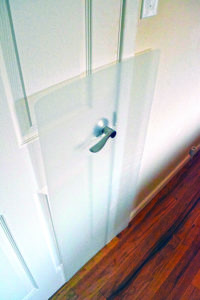
Clawguard
Charlotte, NC
clawguard.com
We were bowled over by the simplicity and effectiveness of this product when we first spotted it at a pet products trade show – a sheet of durable plastic that hangs from the doorknob on the inside of your door and covers both your door and the door frame, preventing your dog from scratching the door or frame. Brilliant!
Clawguard is meant to hang on the inside of doors; this assumes a dog who is inside the house and scratching to get out. As such, it doesn’t interfere with the opening of a door inward. But if you were looking for a solution to protect the outside of a door that swings inward (as in the case of a dog who was locked outside and was trying to get in), you’d have to take the Clawguard off the door before opening it.
One side of the Clawguard sheet is smooth and the other has little ridges. Turn it whichever way you prefer: When a dog scratches on the side with the ridges, his claws make a loud “scritch!” sounds that is enough to dissuade many dogs from scratching again. If you are more averse to the noise than your dog, just turn the Clawguard around.
Clawguard comes in two weights (thicknesses): regular and heavy duty. Doors would be well-protected by the regular Clawguard from smaller dogs and dogs who aren’t strongly invested in scratching, but the heavy-duty would be recommended for dogs with separation anxiety or who have a well-established habit of door-destruction.
The company includes a piece of adhesive-backed hook-and-loop fastener that can be used to secure the bottom of the sheet if needed; in reviews, we’ve seen some buyers mention that they needed to buy more strips of similar material to hold the sheet really firmly in place – a small price to pay to protect your home.
Clawguard can be purchased directly from the company, or for a bit less from online retailers such as Chewy.com and Amazon.com. The company does not take phone orders but is responsive via email.
Pooch Paper 50 sheets: $12
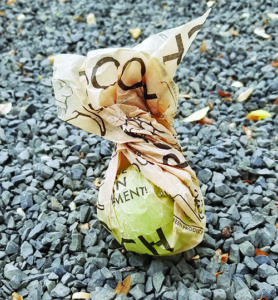
Pooch Paper
New York, NY
littlebooandyou.com
Reducing plastic consumption is an ongoing goal for many of us, but when it comes to poop bags, it’s where may owners draw the line. Biodegradeable bags improved matters somewhat, but still contained plastic – an imperfect solution.
Here’s the first product we’ve found that works well for picking up and disposing dog poop that contains no plastic whatsoever. Pooch Paper a large sheet (about 12 x 12 inches) of recycled, non-chlorine-bleached, coated paper – sort of like wax paper. It’s strong enough to grab even large or squishy piles of poop without breaking or leaking through, and once you have it contained, you just twist up the edges and carry it by the top of the bundle until you find an appropriate place to dispose it. And it’s really, truly, fully biodegradable and compostable.
Folks who are accustomed to picking up and then carrying dog waste for some distance will undoubtedly miss the handles of their environmentally unfriendly plastic bags. But if the poop you have to pick up doesn’t have to be carried far, you’ll find this paper more than adequate for keeping your hands and the earth equally clean.
Pooch Paper comes in a box of 50 folded sheets for $12 for most consumers; dog daycare or shelters might be interested in a box of 4,000 flat sheets for $450. Purchase online from the manufacturer’s Etsy store (Etsy.com/shop/littlebooandyou)
“Raising the worst dog ever” $20
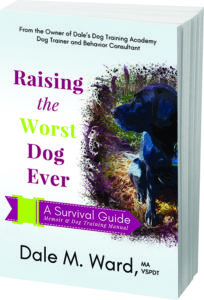
“Raising the Worst Dog Ever”
DDTA Publishing, 2019
Books that are written to inform do this best when they have a story to tell. Dog trainer Dale M. Ward’s new book Raising the Worst Dog Ever: A Survival Guide (DDTA Publishing, 2019) exemplifies this notion. This book is first a thorough, interesting, and progressively minded puppy-raising guide, written for owners who wish to “do things right” with their new family member. Second, it is a personal and touching memoir of Ward’s life with dogs in general, and with one dog in particular, her Labrador Retriever, Wylie (aka “The Best/Worst Dog Ever”).
The book begins with the author’s relocation to a remote area in Wisconsin’s Northwoods region with her new husband. Isolated and often alone in an unfamiliar community, Ward decides to bring a new dog into her life – enter puppy Wylie. Ward tells the story of Wylie’s journey interwoven into her own personal story, using a series of events and adventures that they encounter together during Wylie’s life. This engaging approach is riveting and entertaining – and an incredibly helpful teaching tool. Each vignette includes a section at the end that provides pertinent dog-raising advice. Ward not only delivers excellent dog training information (and the science that supports it), but also includes reams of information regarding dog behavior, the importance of daily routines, dogs’ exercise and enrichment needs, safety and responsible dog ownership, and health – all things that new owners need to know and can benefit from.
While Ward directs her advice to new puppy owners, the breadth and depth of dog training and behavior information in this book will be helpful to everyone from seasoned dog owners to professional trainers. Ward’s and Wylie’s personal stories are poignant and endearing, and the author’s message is uplifting. I found myself falling in love with sweet Wylie and revisiting many of my own cherished dogs from years past. This is a book for curling up next to your dogs, hugging them close, and following the journey of Wylie and Dale’s life together.
The added benefit is that you will also learn a lot about reward-based and dog-centered training methods along the way. Ward is the owner of Dale’s Dog Training Academy, LLC, located in northeast North Carolina. Dale is a certified Victoria Stilwell Positively Dog Trainer (VSPDT), a Fear Free Certified Professional Dog Trainer, and a licensed Family Paws Parent Educator. Readers will benefit from Ward’s dog training experience and knowledge – and be entertained and moved by her stories of life with Wylie. – Linda P. Case
“Canine Enrichment for the Real World” $20
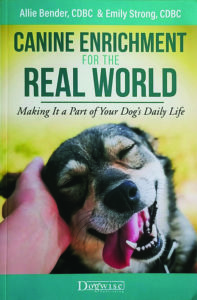
“Canine Enrichment for the Real World”
Dogwise Publishing, 2019
I’m a huge fan of making dogs’ lives as enriched as possible, full of opportunities for them to engage in very doggy activities, exercise for their bodies and brains, and challenges that are within their abilities to solve (but not too easy). But even so, I wondered how someone could think of enough enriching activities and toys to fill a small book, much less a 230-page book!
Silly me; that’s far from all the book discusses; it’s not just a list of games and food puzzles that your dog might enjoy. The authors explain that enrichment is not just giving our dogs things to do or creating an environment that looks good to us. Rather, they say, “Enrichment is learning what our dogs needs really are and then structuring an environment for them that allows them, as much as feasible, to meet those needs.”
They add: “If we don’t understand who dogs are as a species or what their needs actually are, the enrichment process will not get very far. If we rely on myths, misunderstandings, and romanticized notions abut dogs, we are bound to miss the mark when trying to enrich them. For this reason, this book covers a much broader range of topics than most people might expect from a book about enrichment. This isn’t just about toys and play. It’s about who dogs are, the entire spectrum of their physical, behavioral, and instinctual needs, and how we can meet those needs as a part of our daily routine.”
The authors have completely and engagingly succeeded in describing what dogs need in order to be behaviorally, mentally, and emotionally healthy and how, in practical and readily achievable ways, we can provide those things to the companions we love so much.
The authors are highly educated animal behavior consultants (they each have CDBC, CPDT-KA, and SBA certifications) who work with all companion animal species and have extensive dog training résumés. They make the behavioral science that underpins their recommendations accessible to even novice owners and fascinating to even very experienced trainers. I’ll be sending copies of this book home with every foster dog or puppy I place from now on. – Nancy Kerns
BreezeGuards $260 pair
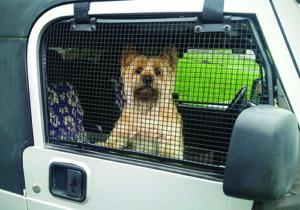
Mutt Managers
Woodinville, WA
(866)653-5631
breezeguard.com
Any of you ever bring your dog with you in the car? Of course! Don’t we all? But it’s gotten more and more worrisome, especially if we park the car and leave our dogs inside for even the quickest errand. When we leave the windows cracked only a bit, we run the risk of either our dogs being too warm or people thinking (erroneously) that our dogs are too warm – and if we lower the windows too much, we run the risk that someone might reach inside and steal our dog, or that our dog jumps out!
Enter BreezeGuards: custom-made welded steel wire mesh cage panels or “screens” that fit your car’s window opening. They are sold in sets of two, to ensure a cross-breeze in your car, and install from the inside of the vehicle to allow for free movement of the window glass, so you can leave them in place when you get back in the car, turn on the air conditioning, and close the windows.

They are also strong enough to contain even a large dog who is motivated to escape your car. If you have concerns about this, watch the installation instruction video on the manufacturer’s website; you’ll see how these are not just mounted by the pressure of the window, like the low-cost plastic screens sold elsewhere. BreezeGuards are custom-made for your exact vehicle model (so they fit the window opening fully and precisely) and have anchors that slide down into the door, between the window glass and the door frame. You can leave them in place and drive with the window open or closed, and open and close the car door normally.
BreezeGuards are made in Washington state and will arrive about three weeks after ordering. Everyone we know who already has them says they will never have another car without them.
Ventlock $20 – $36
Want to increase the airflow in your parked car even more – again, without allowing someone to reach in and steal your safely crated dog or other belongings? Then you might be interested in this ingenious little product, which allows you to prop open your car’s tailgate, rear hatch, or even a side door, while simultaneously preventing the locked door from being opened enough for anyone to reach inside and take things.
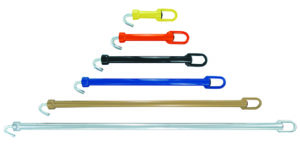
The Ventlock is a steel rod that connects to both ends of the locking mechanisms that latch and lock your car hatch or door. It comes in lengths ranging from four inches (for use with uncrated dogs in cooler weather) to 24 inches (for dogs in large crates only, because otherwise they could escape, and small crates could be stolen).

Clean Run
South Hadley, MA
(800)311-6503
cleanrun.com
There are photos on the Clean Run website that show the Ventlock being used in many different ways, with many different types of cars and trucks. Watch the demonstration video, too, so you can see how the tool is used, and how easy it is to put on and take off (as long as you have the keys to the car!).
If you used an appropriately sized Ventlock on a car’s rear hatch in combination with BreezeGuards, you’d have as much air coming through the car as possible, with as much security for your dog as possible. Sounds like a great tactic for anyone who travels a lot with a dog.
PetAmI waterproof dog blanket $21
When you have dogs, having a few waterproof blankets around is handy, especially in the winter. Waterproof blankets can keep your car seats dry and clean, even when your dog decides to lay down in that huge puddle right before leaving the dog park. They can help your dog get warm and dry after coming back inside from going potty – without making your sofa smell like damp dog. And if you have an older dog with occasional urinary incontinence or one who leaks urine while sleeping, water-resistant blankets are a godsend, preventing the need to launder bulky dog beds or your own bed comforter – just pop the blanket in the washer.
But when a friend recommended this blanket to us as a potential Gear of the Year entry, we were frankly dubious. One side of the blanket is fleecy; the other is smooth. It just doesn’t look like the sort of blanket that would be waterproof. Most of the water-resistant bed covers and blankets we’ve seen were not very inviting fabrics; they mostly seemed sort of canvas-like. This blanket looks fluffy and soft!
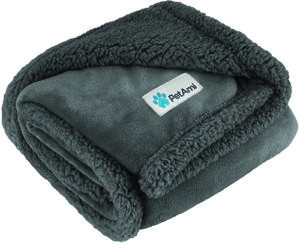
PetAmi Waterproof Dog Blanket
amazon.com
We expressed our skepticism – to which our friend responded with a video she made, where she poured a glass of water over the blanket so we could see the water pool on the top, and then run right off when she held the blanket upright. Well, all right!
Our friend has a 70-pound dog who sometimes experiences urinary incontinence while asleep, and this blanket, our friend says, has contained the whole, um, issue on more than one occasion. In the nine months our friend has owned it, she has washed the blanket a number of times and says it’s still repelling the occasional accident – and demonstration!
Available in at least a dozen colors and patterns. Our only bone to pick: The PetAmi Waterproof blanket is only 30 by 40 inches.
Zee.Bed $90 – $120
Have you ever bought one of those space-age mattresses that comes tightly wrapped – a heavy, dense roll of compressed foam that expands to several times its size when cut free of the wrapping? If so, and if you love sleeping in that bed – well, you just might love this similar bed for your dog, too.
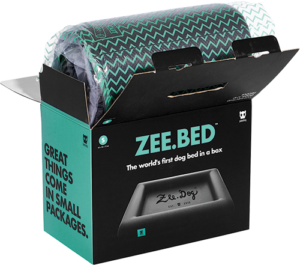
The core of the Zee.Bed is a “viscoelastic foam” – a type of memory foam that breathes and molds itself to your dog, no matter his resting posture. It’s molded in a rectangle, with a raised edge that serves as a pillow for dogs with a sprawled sleeping style or gently contains dogs who sleep curled in a ball. The bed’s base features anti-slip rubber nubs that keep the bed in place, and its cover has an all-the-way-round zipper that allows for ridiculously easy removal and replacement after washing. The Zee Bed comes in two sizes: the Small is 22 x 25 inches; the Large is 28 x 32.
Zee.Dog says it takes about three hours for the bed’s foam, maximally compressed for shipping, to puff up to its ultimate, cushiony thickness. Less than an hour into the expansion process, our test dog checked out the bed. After a few exploratory sniffs and circles, he deemed it better than all the other beds scattered around our office, and wouldn’t get off until dinnertime.
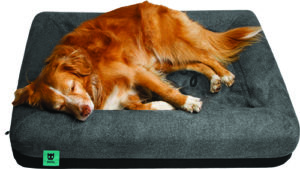
Zee.Dog
Raleigh, NC
zeedog.com
Zee.Dog offers a $40 to $60 “Watershield” bed cover as an accessory. It’s a thin synthetic ripstop fabric that’s meant to be used to cover the foam core of the bed, under the Zee.Bed’s microfiber cover, preventing any liquid from reaching the foam (the memory foam, like your own memory foam mattress, is not intended to be washed).
The company does not take phone orders but is responsive via email.
Lakse Kronch Pocket trainers $6
Look, we know that treats that consist solely of fresh roasted meat or fragrant cheese are what dog trainers mean when they suggest using high-value treats. But sometimes, you need a treat that’s smells super interesting to your dog but that you can carry in the pocket of your jeans or skirt – a dry treat that is nevertheless of sufficiently high-value for training in even a very distracting environment. That’s where Lakse Kronch Pocket Trainers excel!
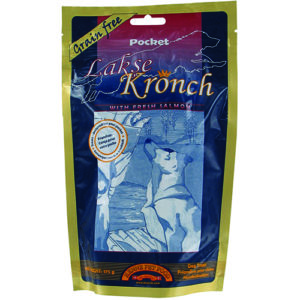
Kronch USA
Sanford, NC
(866)457-6624
kronchusa.com
These treats are made with salmon (76%) and potato meal (24%) – that’s all. The maker calls them “pocket treats” because many dog owners enjoy putting the dried treats in their pockets for dog walks without having to worry about the smell of salmon being left on their clothing. But believe us: Dogs can smell the deliciousness.
Kronch USA says the salmon in the treats is fresh, never frozen, Norwegian salmon that is processed within 24 hours of being caught. The treats contain no ethoxyquin or other preservatives and are made in Denmark. They make terrific, behavior-building treats or very healthy supplements for your dog.
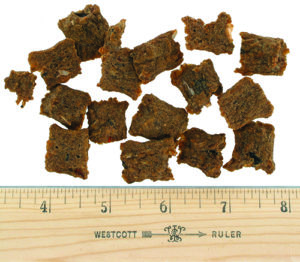
Note: We purchased from CleanRun.com.
Lotus Ball $12
Treat Hugger $9
The Lotus Ball is not really a ball – it’s so light-weight that you can’t throw it very far; it’s more of a treat-dispensing toy.
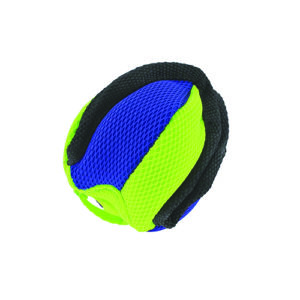
But it’s not the type of food-puzzle that you give to your dog to occupy his time while you are engaged in something else.
The Lotus Ball (and the Treat Hugger) belong to a category of their own: toys that hold food but are used for training lures and/or rewards. The toy aspect is most reinforcing to some dogs – and when they discover that there are delicious treats inside, it makes the toy even more rewarding. Food-motivated dogs will be drawn to the aroma of the treats you stash inside, but will have to work for a moment to get at the treats – and most behavior experts agree that the anticipation of the treat is almost more reinforcing than the treat itself!
An added bonus is that you can throw these treat-laden toys, helping to deliver a reward to your dog at a distance from yourself – very useful for sports training!
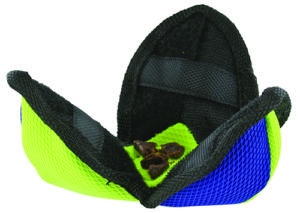
The Lotus Ball is designed a bit like a flower, with three stuffed mesh “petals” that connect along their edges with a hook-and-loop (Velcro-like) fastener. The mesh makes the aroma of the treats inside very accessible, tantalizing your dog and motivating him to use his paws and mouth to open the toy to reach them.
The Lotus Ball is available in three sizes: Mini, Small, and Medium. Clean Run also sells a Lotus Ball Braided Fleece Tug ($15) – a fleece Lotus Ball with an 18-inch fleece-braided “tail.”
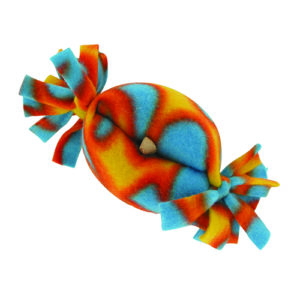
Clean Run
South Hadley, MA
(800) 311-6503
cleanrun.com
The Treat Hugger operates in the same way, but has no hook-and-loop fastener to slow down the dog who has earned the treat. Instead the treat is held in a crevice in the center of the toy; it’s much easier to get it out, making this toy more appropriate for puppies or dogs who don’t have strong foraging skills. Also, some dogs are averse to the “ripping” sound that hook-and-loop fasteners make when torn apart; the Treat Hugger has no Velcro-like fasteners, making it more ideal for these sound-sensitive dogs. It also contains more stuffing than the Lotus Ball and so appeals more to dogs who especially like stuffed toys.
If your dog gets quickly bored of the same old treats or toys, or gets distracted easily, these toys might be just the ticket. They are great tools for helping you keep your dog keen and focused – eyes on the prize(s)!


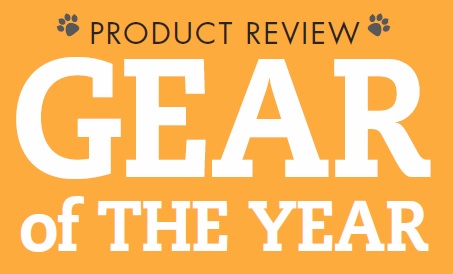




While is was trialing my dogs I used 2 different sized of VentLocks, depending on the weather that day, and I loved them. They are easy to get on and off and they really help with airflow.
The only problem with memory foam beds is that they have toxic chemicals for both humans and dogs. I personally would only use a latex bed for my dogs (and it is easy and inexpensive to buy a piece of latex and put a homemade cover on it. Latex folds up nicely for trips too.
Agree about the chemicals.
I totally agree. Chemicals would be right where they breathe and are bad no matter what. Latex is good.
Where are the ‘best’ harnesses?
Wild One has the best by far that I have found. Very well made, comfortable, absolutely don’t rub under their front legs like most do, and do not have a strap coming across their shoulder which can alter their movement and cause problems. I’ve tried several and these are the greatest for my two large dogs, they also have top and front clips. About $75.
Thanks for the updates!
Love your newsletter..just started reading!
Happy holidays!
Angel
I just looked up the PetAmi waterproof blanket and they do indeed come in larger sizes with albeit a larger price tag which is to be expected.
The pocket trainer treats are a great idea, I like to walk in my Sunday’s best without my ubiquitous treat pouch hanging from my belt and still carry some treats to rewards my puppy on our walks, I live in NYC, and would like to find a retailer near me.
This is a great list of items for my pup. I particularly like the paper poop bags to reduce plastic consumption!
Wow these are all great ideas and I will be using most so thank you!!